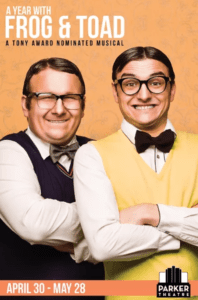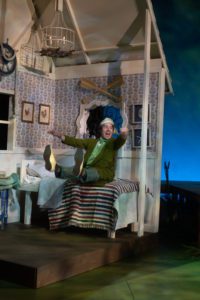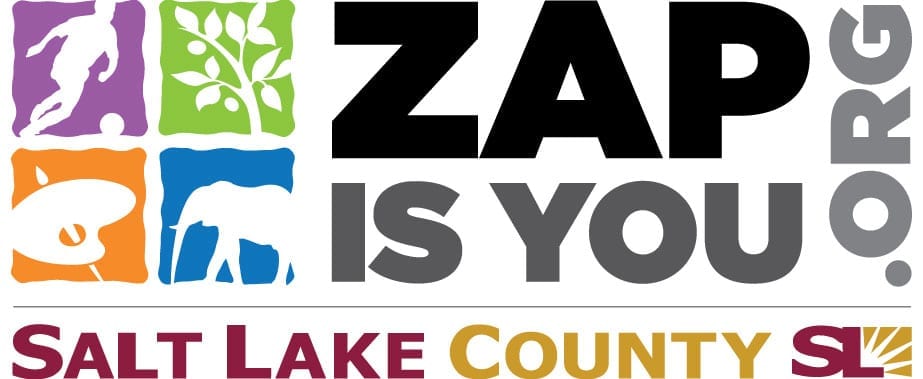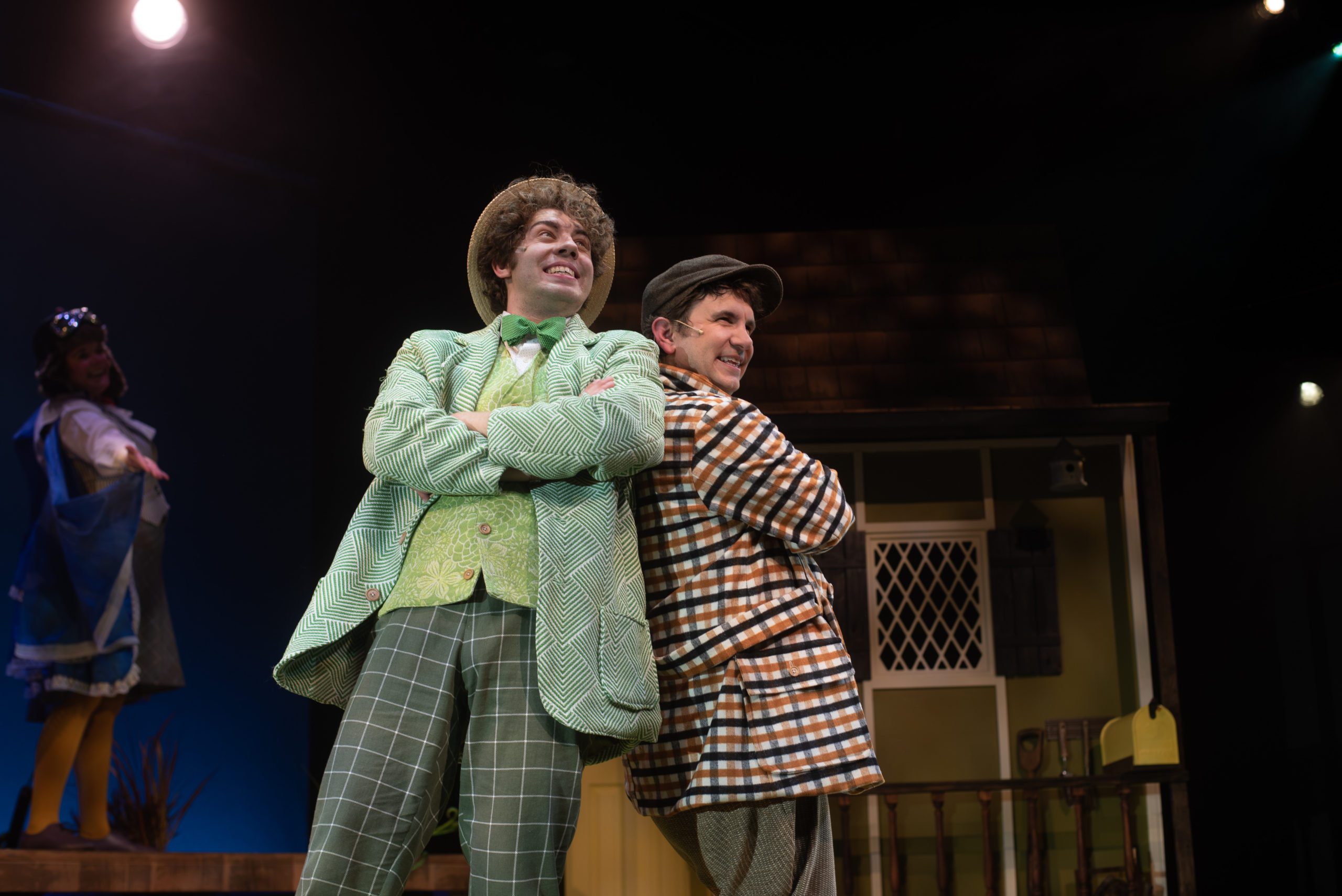SOUTH SALT LAKE — I have a high bar for theater for young audiences (TYA). In addition to being a parent of young children and a middle school theatre teacher, I run a podcast about TYA, hold an advanced degree in the field, and have seen some of the best TYA practitioners world wide. The Parker Theatre’s production of Willie and Robert Reale’s A Year With Frog and Toad met my high expectations.

In my mind, there are three key criteria for a successful TYA production that A Year With Frog and Toad met. First, TYA needs to bring the same quality production value in terms of lights, sound, set, costumes and props as I would expect with any play. If it feels amateurish, that is not TYA; it is just bad theater. The second is that it needs to cater effectively to both adults and children. While children are the intended appreciators, adults are the ones buying tickets and they will not pay for what they do not like. Third, the show should give me things to think about before, during and after, as TYA has its roots in education as well as performance.
The Parker Theatre is located off of state street in south Salt Lake in an area that does not scream “arts and culture.” It is a venue that would be easy to overlook, and I was not sure what to expect going in. Upon seeing the stage, I was immediately taken with the enchanting set designed by James B. Parker. TYA engages through vivid color and detail, as well as through simple and playful convection. Parker’s set consists of two large houses that swivel to show the interior and exterior of Frog and Toad’s houses, as well as a large multipurpose platform in the middle that serves as various locations that Frog and Toad visit, and the spaces were beautiful built and full of details that were fun to look at without being distracting.
 The story (based on the stories by Arnold Lobel) begins with three birds returning north from their winter migration and explaining that Frog (played by Taylor Seth Hall) and Toad (played by Clark Bullen) are just waking up from hibernation. Hall plays the lively and optimistic Frog and brought exuberance to his character. Hall used his body well to communicate the feelings and intentions of his character that were varied and engaging. Towards the beginning of the play, Hall mischievously changes the calendar on Toad’s wall to get him to end hibernation earlier than planned. Later in the play Frog sits pensively alone, and comforts the well meaning toad, who feels embarrassed about intruding on his solitude. Through each emotional arc of the story, Hall brought a sense of understanding of the character’s motivations that resonated with me. It also spoke well to my six-year-old son who was in attendance and spoke articulately about the broad range of feelings he could see in Frog’s expression of his character.
The story (based on the stories by Arnold Lobel) begins with three birds returning north from their winter migration and explaining that Frog (played by Taylor Seth Hall) and Toad (played by Clark Bullen) are just waking up from hibernation. Hall plays the lively and optimistic Frog and brought exuberance to his character. Hall used his body well to communicate the feelings and intentions of his character that were varied and engaging. Towards the beginning of the play, Hall mischievously changes the calendar on Toad’s wall to get him to end hibernation earlier than planned. Later in the play Frog sits pensively alone, and comforts the well meaning toad, who feels embarrassed about intruding on his solitude. Through each emotional arc of the story, Hall brought a sense of understanding of the character’s motivations that resonated with me. It also spoke well to my six-year-old son who was in attendance and spoke articulately about the broad range of feelings he could see in Frog’s expression of his character.
For all of Frog’s exuberance, Toad’s character is a consistent worrier who finds himself on the butt of other animal’s jokes. Bullen had a great toad-like gait and revealing expressions that hinted at his inner worries. However, at times it felt more like Bullen indicated that Toad was worried — rather than letting Toad simply be a worried character. It read well to me as an adult audience member, but it meant lower stakes for the story overall. Toad faces many obstacles such as being frustrated by his lack of mail, dismayed about his broken clock, anxious that Frog has abandoned him, and more. I felt that the portrayal of most of these emotions were similar and lacking the distinction that would have made the character have more life and variety.

The rest of the cast consisted of three ensemble members (Ian John Wellisch, Chelsea Marsden, and Jana Lynne Cox), who played various creatures near the pond where Frog and Toad live. Marsden was my favorite to watch in her various roles. Her many characters were dynamic with distinctive voices and movements. She also seemed to be discovering every new moment in the story for the first time. This was particularly evident when she found freshly raked leaves outside Frog and Toad’s homes and jumped in with all the unbridled enthusiasm of a child. Wellisch was also a strong mover and actor whose most engaging role was the mail snail who had several reprisals through the show as he took a letter slowly from Frog to Toad. Each instance of the snail appearing was fresh and delightful in ways that both my son and I appreciated. Cox had a rough start to the show, as she seemed out of sync with the other members of the ensemble, particularly in choreography. However her role as Frog’s mother showcased her powerful singing voice that was a huge strong suit for her. Her enthusiasm throughout and willingness to simply play was fun and helped keep these three cohesive in tone and style as performers.
 Vocally all of the performers were strong singers, with Cox as the clear highlight. The song that will stuck with me and my son, “Cookies,” is just before intermission as Frog and Toad cannot refrain from eating and sharing Toad’s deliciously made cookies. The song is catchy without being grating, and helped propel the second act of the show. It also, at least in my case, led to the purchasing of cookies from concessions that were as good as I hoped.
Vocally all of the performers were strong singers, with Cox as the clear highlight. The song that will stuck with me and my son, “Cookies,” is just before intermission as Frog and Toad cannot refrain from eating and sharing Toad’s deliciously made cookies. The song is catchy without being grating, and helped propel the second act of the show. It also, at least in my case, led to the purchasing of cookies from concessions that were as good as I hoped.
Some may be skeptical of how high quality a play for children can be. If that’s you, A Year with Frog and Toad at the Parker Theatre is a good place to start. Clocking in at about 90 minutes (including intermission), the director Brett Meyers’s pacing of the show was fun and enjoyable. Utah’s universities have long had TYA as part of their seasons, and increasingly professional theatres in Utah are starting to develop more of a presence in TYA. Frog and Toad was worthy of every TYA performance I have seen in the state. My six-year-old was engaged and entertained, though I probably laughed more than he did. I look forward to another opportunity to see a TYA production at the Parker Theatre. If you have not had the chance to see A Year with Frog and Toad, hop to it!
[box]A Year with Frog and Toad plays Fridays and Saturdays at 7:30 PM and Saturdays at 4:30 PM through May 28 at the Parker Theatre (3605 South State Street, South Salt Lake City). Tickets are $20-22. For more information, visit www.parkertheatre.org.[/box]

